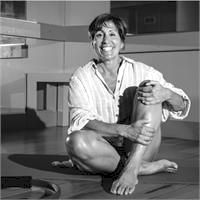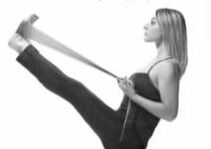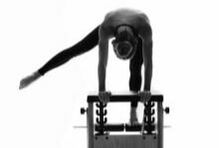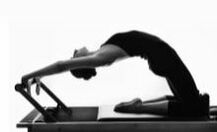Pilates
The method of exercise takes its name from Joseph Hubertus Pilates, a native of Germany born in 1880. A frail child, he suffered from many childhood diseases; as a result, devoted to life to developing a mind-body excercise system of over 500 movements leading to a strong, balanced and flexible body. For 75 years, athletes, dancers, fitness buffs and those individuals recovering from injuries have utilized the Pilates Method to keep their bodies injury-free and in top shape.
An inquistitive boy, Pilates studied anatomy, ancient Greek and Roman exercise practices and eastern philosophies. He spent time outdoors studying the movements of animals in their natural habitats. By the age of 14, Pilates had remade his scrawny body into one that was used as a model in anatomical charts. he pursued interests in gymnastics, wrestling and boxing as an adult, and during WW1, found himslef in an internment camp in England. It was during this time that he began to develop a series of rehabilitating and strengthening movements. He practiced on injured individuals as they lay in hospital beds - placing their arms or legs into straps attached to springs he had removed from the bed and attached to the wall for resistance. Hence, when we see the hallmark pieces of Pilates equipment, the Reformer and Cadillac, we see how they evolved from this original work on hospital beds.
After the war ended, Pilates went back to Germany and continued his work, eventually training law enforcement officals in Hamburg. Disagreeing with the state of politics in Germany, he left the country in 1925 and boarded a ship to come to the United States. Pilates met his wife, Clara, on the way here. She became his professional partner as well, and together, the opened a studio in New York City based on his method of exercise, which they called Contrology. The studio was in the same building as the New York City Ballet. Joe and Clara continued to refine the technique and began to help injured and exhausted dancers rehabilitate their bodies to become stronger and properly aligned.
For many years until his death in 1967 at 86, most of the dance community discovered and embraced Contrology. At the same time, Pilates was very protective over his work and was careful to pass it on only to his students (now called the "Pilates elders") whom he believed could maintain the integrity of the movements. Therefore, Pilates remained a mystery to much of the general population. After Joe's death, Clara selected a few students to take over the teaching of his method of body conditioning which came to be known as Pilates. She died in 1977.
An inquistitive boy, Pilates studied anatomy, ancient Greek and Roman exercise practices and eastern philosophies. He spent time outdoors studying the movements of animals in their natural habitats. By the age of 14, Pilates had remade his scrawny body into one that was used as a model in anatomical charts. he pursued interests in gymnastics, wrestling and boxing as an adult, and during WW1, found himslef in an internment camp in England. It was during this time that he began to develop a series of rehabilitating and strengthening movements. He practiced on injured individuals as they lay in hospital beds - placing their arms or legs into straps attached to springs he had removed from the bed and attached to the wall for resistance. Hence, when we see the hallmark pieces of Pilates equipment, the Reformer and Cadillac, we see how they evolved from this original work on hospital beds.
After the war ended, Pilates went back to Germany and continued his work, eventually training law enforcement officals in Hamburg. Disagreeing with the state of politics in Germany, he left the country in 1925 and boarded a ship to come to the United States. Pilates met his wife, Clara, on the way here. She became his professional partner as well, and together, the opened a studio in New York City based on his method of exercise, which they called Contrology. The studio was in the same building as the New York City Ballet. Joe and Clara continued to refine the technique and began to help injured and exhausted dancers rehabilitate their bodies to become stronger and properly aligned.
For many years until his death in 1967 at 86, most of the dance community discovered and embraced Contrology. At the same time, Pilates was very protective over his work and was careful to pass it on only to his students (now called the "Pilates elders") whom he believed could maintain the integrity of the movements. Therefore, Pilates remained a mystery to much of the general population. After Joe's death, Clara selected a few students to take over the teaching of his method of body conditioning which came to be known as Pilates. She died in 1977.
What Can Pilates Do For You...
"Not only is health a normal condition, but it is our duty not only to attain it but to maintain it. " - Joseph H. Pilates
Achieve success at Main Line Pilates:
Achieve success at Main Line Pilates:
- Elongate muscles without building bulk.
- Slim and tone problem areas – Core, hips, buttocks, thighs and arms.
- Strengthen the back by building support in the abdominals.
- Increase flexibility while building strength.
- Improve posture, coordination, circulation and overall health.
- Lower risk of injury by eliminating tension and stress on joints, back, and neck.
- Increase range of motion.
- Promote relaxation and a sense of well being
Contact
Main Line Pilates
Purenergy Studios
The Depot Shoppes
21 Plank Avenue
Paoli, PA 19301
Studio Tel: 610.993.9933
Gina Cell: 610-7453036
Purenergy Studios
The Depot Shoppes
21 Plank Avenue
Paoli, PA 19301
Studio Tel: 610.993.9933
Gina Cell: 610-7453036




